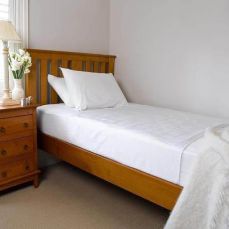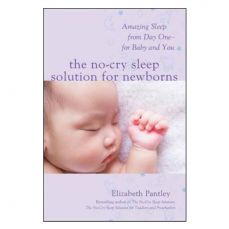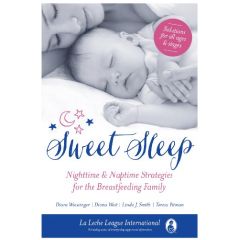Setting up your bedroom for sleep Sleep Suitable for stages: Pregnancy, 0 - 3 Months
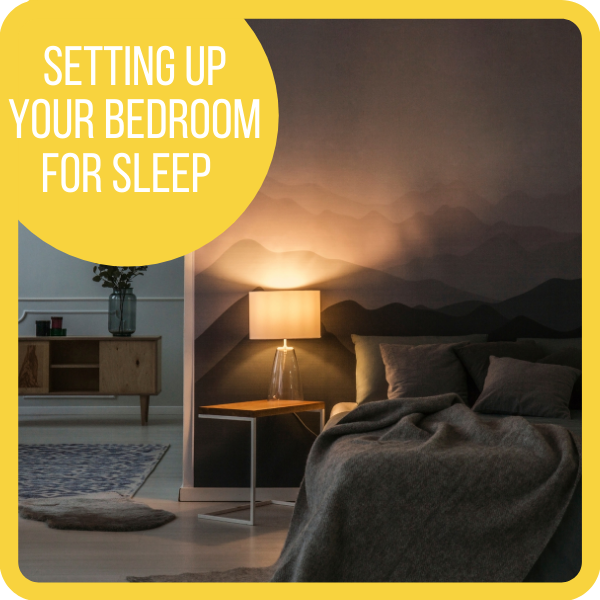

When you have prepared your body and mind for sleep, and are ready to sleep, you want your bedroom environment to support falling asleep, staying asleep and sleeping well. The need for quality sleep amongst new parents can become a desperate situation due to the differences between infant sleep and adult sleep. Therefore, setting up the bedroom environment for the primary purpose of better sleep and relaxation will be essential for the household to function.
We spend roughly 1/3 of our lives sleeping. Since your bedroom is primarily for sleeping in, you are spending a lot of time there. Of course, the bedroom is often used for other activities such as intimacy, dressing/undressing, reading and relaxing. Therefore, it must function as a suitable space for all these activities to occur, including future functions such as feeding your baby.
When your bedroom makes you feel safe, secure, calm and comfortable, it is serving its function. Calm can be created in your bedroom space in many ways. It can be as simple as having your bed made, and uncluttered and tidy space. Other bedroom environment features worth looking critically at including the materials and fabrics, the quality and temperature of the air, the light quality, and the electrical energy in the room. Working towards a healthier bedroom environment as you can afford to will be worth the effort.
Healthy bedroom checklist
Bed
It wouldn't be uncommon to want to go out to buy a new bed during your pregnancy if your bed is getting on the saggy side or just not supporting where it needs to (think 'the princess and the pea').
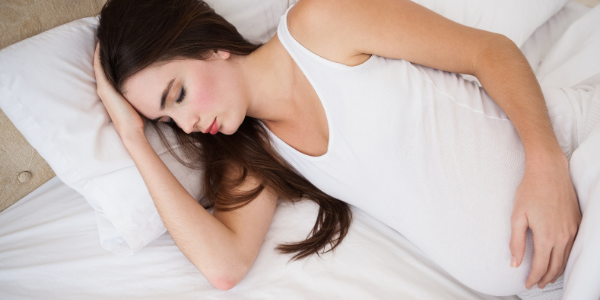
Taking a critical look at your mattress and the size of your bed before your baby arrives, can save a lot of discomfort in the long run. Towards the end of the pregnancy, it becomes increasingly difficult to find a comfortable position and you can experience various sleep stealers.
It is recommended to sleep on your left side (or right side second best) to improve the flow of blood and nutrients to your baby and help kidney function. Sleeping on the left side is thought to have multiple health benefits for anyone, including:
- better brain function (facilitates lymphatic drainage)
- better kidney and circulation elimination
- facilitates the flow of bile and gastric juices
- improved heart circulation/reduced congestion
- the position of the stomach and pancreas releases digestive juices reducing indigestion
- reduction of snoring where the flow of oxygen is reduced to the body.
If you were a tummy sleeper, you may find that this is no longer comfortable due to tender breasts and pressure on the bladder which is competing for space with your growing uterus (mainly in the 1st and 3rd trimester).
Sleeping on your back may be comfortable with several pillows to raise your chest level in the final stages of pregnancy. It can be more comfortable sitting up in bed if you have a padded headboard to lean against. This position can help with reducing symptoms of reflux or heartburn. It is worth knowing that sleeping on your back in late pregnancy is associated with a 2.6-fold increase* of stillbirth odds due to compression of the inferior vena cava and aorta which significantly reduces blood flow. Sleep-disordered breathing is also associated with stillbirth due to the reduced oxygen levels in the body. This is all the more reason to tune into your body and your baby when you are resting to find a comfortable position and position your body to optimise your breathing while you sleep.
An old or hard bed may become unbearable due to your changing body shape, additional weight, and soft ligaments, especially around your pelvis. You may find yourself shopping for a new bed or at least a soft topper.
Using pillows between the thighs and legs and supporting the back can be more comfortable for side sleeping and lessen the pressure on the joints (due to relaxed joint ligaments). This can be achieved using regular pillows, boomerang pillows, or purchasing a pregnancy pillow.
This broken and light sleep could have you wondering if it’s by design and part of the preparation for waking up to your newborn baby at night. Think of all this as dress rehearsals for when the baby arrives and that it means that you will meet your baby soon. Regardless, you still want to maximise your sleep before your baby arrives.
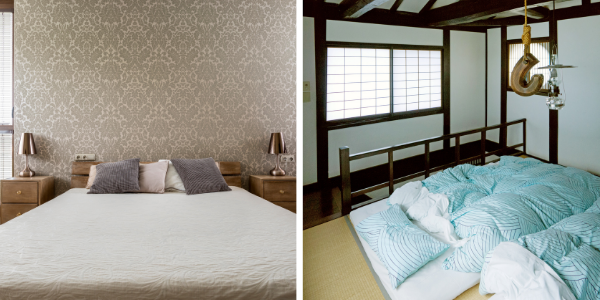
Bed size becomes important when you have children. Having at least a queen-sized bed for 2 adults is a must when expecting. Considering a larger bed such as a king-size or super king-size bed could be considered insurance for the future of your sleep. It is possible to enforce a strict no kids in your bed policy; however, it is inevitable for most parents that their bed becomes the family bed at some point, if not often.
In Japan, co-sleeping is the norm, as is sleeping on a futon mattress on the floor. When shopping for beds in Japan, they have mattress sizes for families of 3 or more. In many other parts of the world, sleeping with young children until they are ready to be independent is expected behaviour and a way to keep them safe and secure at night.
In Australia depending on where you live, a floor bed may feel a bit of a risk for spiders to wander in, so a low height bed with safe side barriers may be a good compromise. Another option is to put a single or king single against your bed, making a super-sized family bed. The smaller bed can later be moved into the kids room when they grow out of needing to be so close.
It’s also a good time to start stocking up on good quality waterproof mattress protectors (2 or 3) these will get a lot of use over the parenting years.
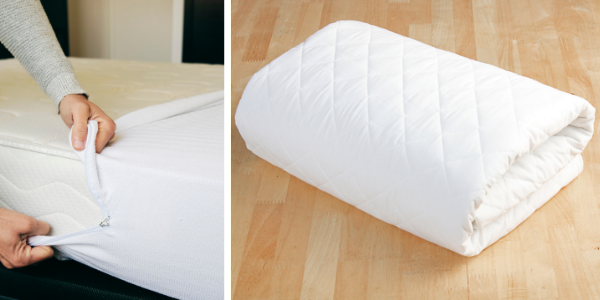
Materials & Fabrics
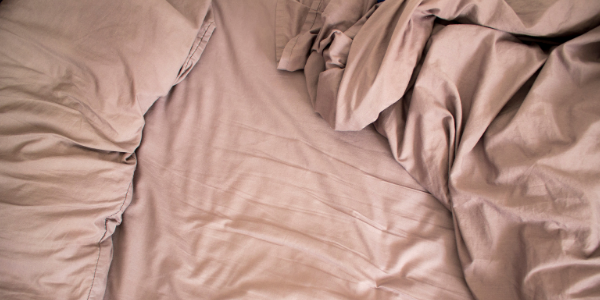
What fabrics and bedding materials including the mattress, linen, pillows, pyjamas, clothes, carpet/rugs are in this room?
Your bedroom is full of fabrics: on the bed, your clothes and often, the floor coverings. The quality and material of these fabrics matter especially when you spend 1/3 of your day lying in this space and the majority of your day with these clothes directly on your skin. It’s amazing what they have done with chemistry to create modern synthetic fabrics with qualities superior to natural fabrics and materials in many ways. Unfortunately, the cost of that advancement exposes our bodies to these materials through our indoor air quality (airborne particles we breathe in and ingest) and through direct contact with our skin.
Natural fabrics: Similarly, to synthetic fabrics, natural fabrics (including cotton, linen, wool, cashmere, silk and hemp) can be produced using chemical treatment or farming methods. These methods are used because they increase yields and give the fabrics additional qualities. The cost is that these substances can remain as residue on or in the materials. Where you can afford it, consider replacing existing fabrics with organic or sustainably grown products, especially for your bedding linen, pillows and pyjamas.
Air quality
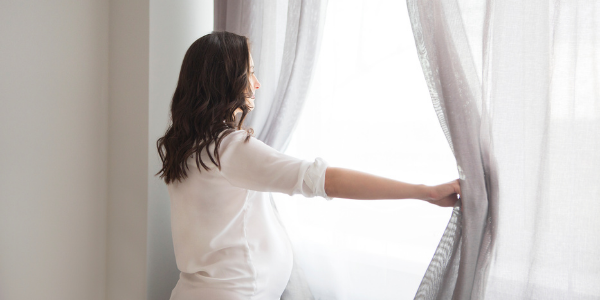
Your nose is a great tool to figure out what smells fresh and healthy and smells not so right or safe. During pregnancy, your sense of smell is heightened to help you to protect your baby from exposure to toxins. Some, often cheaper plastics, materials, will ‘off-gas’ meaning they will release their chemicals into the air - there can be a noticeable smell, or the smell could be subtle.
Start to notice fragranced products and make a point to check the label. Up to 95% of fragrances found in products are made with synthetic chemicals. Any unnamed chemicals can be added to products and listed as 'fragrance' on the ingredient lists. These chemicals have been found in the womb and reproductive system of fetus’ and have known health effects. Before deciding to bring anything into your space, do a smell and ingredients check. A great place to start is with your washing machine detergent - choose fragrance-free and the most environmentally friendly option you can find.
You can help improve indoor air quality by regularly vacuuming, dusting and creating airflow in and out of the room. Air out the room by regularly opening the window and door, putting on a fan and/or using a good quality air purifier. Additionally, look out for moisture and take notice if you find or smell mould. If you live in a high humidity area, you may benefit from using a de-humidifier and/or products that absorb excess moisture. Mould and the mould source need to be removed and rectified as soon as possible and in the safest, most effective way.
Room temperature
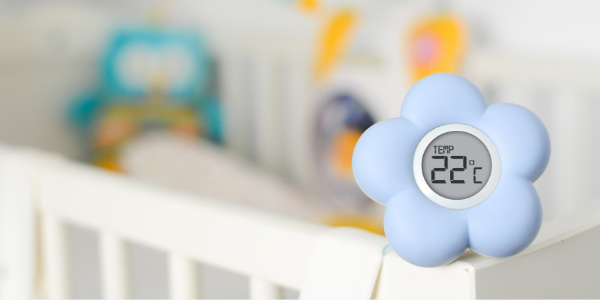
The temperature in your room will be determined by factors such as the outside temperature/season, airflow through the bedroom (such as through gaps around the window or under the door), the floor materials and insulation surrounding the room.
During pregnancy, your body temperature runs slightly hotter, so your experience of the room temperature may be different to your partner's. Your body temperature lowers before it's time for bed and remains low until a few hours before you wake. Having a bath an hour or two before bedtime can lower your body temperature to prepare your body for sleep.
The temperature of the room matters especially if you are too hot. Insomnia has been linked to the body running too hot at night with improvements seen lowering the body temperature by 1 degree. If you are curious, you can buy a thermometer that measures room temperature or go by how you feel to help you decide whether it is too hot or too cool. Ensure you have a way to cool the room down if it is too hot such as a ceiling fan, air conditioner, window, floor fan etc.
Light
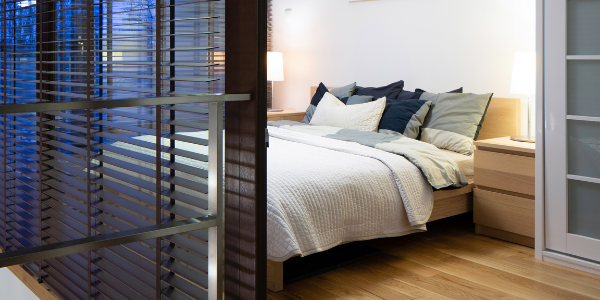
There is some research into how your 24 hour body clock or circadian rhythm is affected by light and different types of light. You were not born with a functioning circadian rhythm - it started to strenghten from around 3-4 months old and continued to develop, maturing at around 4 years old. This is why younger babies sleep are not overly affected by light exposure.
Your body takes cues from the rising and setting of the sun and our exposure to daylight throughout the day. When your day starts with your eyes being exposed to natural sunlight (such as opening the blinds or curtains), this stimulates your body to regulate your body clock hormones and put you in an alert state.
Our eyes have light receptors which find blue daylight alerting, stimulating and delay the sleep hormones that control your body clock. An easy solution is to make your bedroom a blue light screen-free zone including TVs, tablets, computers, & phone devices.
As a light source for after the sunsets, humans have long had access to red based lights in the form of fire from burning wood, gas or coal. Interestingly, red-based light (like candle-light or from older style incandescent bulbs) has less impact on our eye’s light receptors and is less likely to stimulate wakefulness. Where light is needed in your bedroom, yellow/orange/red hued light sources such as a Shnuggle Moonlight Nightlight or a Himalayan salt lamp can be used. Low lighting at night creates a calmer home environment and acts as a sleep cue for kids and adults alike.
Electrical energy
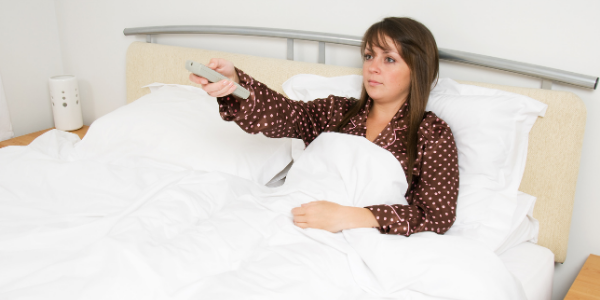
When we sleep, our nervous (electrical) system and all other systems are in rest, recharge and recovery mode. The other electrical systems in our home, including our wired outlets, devices, and wi-fi signals can interfere with our bodies' systems, with young people being particularly vulnerable.
The electric field emitted from power points are believed to disrupt body processes given that your body produces it’s own electromagnetic field (EMF) throughout all the cells of your body but primarily through the heart. Moving your body away from these sources can give you the best chance of avoiding disruption to its processes and support restoration overnight. To what extent is hotly debated, but to be on the safe side, it is not hard to set up our room and get into simple habits to minimise our exposure when sleeping.
Simple things to try:
- Choose the wall for your bed with the least power outlets or furthest away from power units such as air conditioners or switchboards (check the exterior of the bedroom walls).
- Have power outlets turned off at the switch when not in use to reduce the power output.
- Turn off wi-fi and mobile data when you go to bed or better still only use mobile data or wi-fi if & when you need it. Consider installing ethernet ports through the home then connect your device directly for high-speed internet.
- Don’t have your mobile phone or other connected devices in the bedroom, place them in another area of the house overnight. If you use your mobile as an alarm, set it loud enough to hear from the bedroom. Otherwise, place your alarm clock well away from the bed and opt for battery operated over outlet powered.
- Use electric blankets if you need to before getting into bed and switch off at the wall when sleeping. Alternatively, you can use a hot water bottle to warm the bed before you or baby gets in.
There you go, even just doing one of these changes to your bedroom environment will be a step towards a healthier sleeping environment. Over time and as you can afford, you will be moving towards a better night's sleep. The next step is to consider and decide where your baby will sleep and prepare a sleep space for them.
Please note: Above all, any information on this website aims to provide general ideas for informational and educational purposes only. We encourage users to investigate several information sources, including, where necessary, independent individualised medical advice before making any decisions that could affect you or your child’s health or wellbeing.
* BabyPeg participates in various affiliate programs and may earn a commission for referring our users through the links provided. This is at no additional cost to our users. We take great care in choosing products and services which align with the mission of promoting better health and wellness for our BabyPeg community. Where possible, products are tried and tested by us. To continue to provide BabyPeg as a free service and reach as many parents as possible, we appreciate your support in using the link provided to purchase if you decide the product is right for you.





